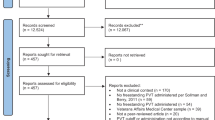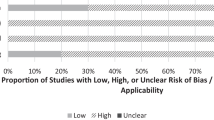Abstract
This cross-sectional study examined abbreviated Test of Memory Malingering (TOMM) indices, including Trial 1 (T1) and errors on the first ten items of T1 (TOMMe10), and their respective concordance to assess whether the administration of Trial 2 (T2) provides incremental value. Pass/fail concordance between TOMMe10, T1, and T2 was examined among a diverse mixed clinical sample of 414 neuropsychiatric patients. Of those who failed TOMMe10 or T1, 74% and 77%, respectively, went on to fail T2. For those failing TOMMe10 and T1, 82% failed T2. For those failing T1, 0% passed T2 if T1 was below 30, 13% passed T2 if T1 was 30–34, and 33% passed T2 if T1 was 35–39. Further, 60% of those who failed T1 with scores below 40 also failed two or more independent performance validity tests (PVTs). Using currently accepted practice standards of two or more independent PVT failures as indicative of invalid performance, 93% of those with T1 scores below 30, 80% of those with T1 scores of 30–34, 70% of those with T1 scores of 35–39, and 41% of those with T1 scores of 40–41 failed at least one other independent PVT and, thereby, would be classified clinically as demonstrating invalid neuropsychological test performance. Collectively, results indicated TOMM T2 administration is unnecessary with T1 scores below 35 or above 41. Patients with T1 scores of 35–41 had relatively lower rates of invalid performance on T2, although the implications of potential T1/T2 discrepancies for overall validity status remain unclear.
Similar content being viewed by others
References
Alverson, W. A., O’Rourke, J. J. F., & Soble, J. R. (2019). The Word Memory Test genuine memory impairment profile discriminates genuine memory impairment from invalid performance in a mixed clinical sample with cognitive impairment. The Clinical Neuropsychologist, 33, 1420–1435. https://doi.org/10.1080/13854046.2019.1599071
Bailey, K. C., Soble, J. R., Bain, K. M., & Fullen, C. (2018). Embedded performance validity tests in the Hopkins Verbal Learning Test – Revised and the Brief Visuospatial Memory Test – Revised: A replication study. Archives of Clinical Neuropsychology, 33(7), 895–900. https://doi.org/10.1093/arclin/acx111
Bain, K. M., & Soble, J. R. (2019). Validation of the Advanced Clinical Solutions Word Choice Test (WCT) in a mixed clinical sample: Establishing classification accuracy, sensitivity/specificity, and cutoff scores. Assessment, 26, 1320–1328. https://doi.org/10.1177/1073191117725172
Bain, K. M., Soble, J. R., Webber, T. A., Messerly, J. M., Bailey, K. C., Kirton, J. W., & McCoy, K. J. M. (2021). Cross-validation of three Advanced Clinical Solutions performance validity tests: Examining combinations of measures to maximize classification of invalid performance. Applied Neuropsychology: Adult, 28(1), 24–34. https://doi.org/10.1080/23279095.2019.1585352
Boone, K. B. (2013). Clinical practice of forensic neuropsychology: An evidence-based approach. Guilford Press.
Boone, K. B., Lu, P., & Herzberg, D. S. (2002). The Dot Counting Test manual. Western Psychological Services.
Critchfield, E., Soble, J. R., Marceaux, J. C., Bain, K. M., Bailey, K. C., Webber, T. A., Alverson, W. A., Messerly, J., González, D. A., & O’Rourke, J. J. F. (2019). Cognitive impairment does not cause performance validity failure: Analyzing performance patterns among unimpaired, impaired, and noncredible participants across six tests. The Clinical Neuropsychologist, 33(6), 1083–1101. https://doi.org/10.1080/13854046.2018.1508615
Denning, J. H. (2012). The efficiency and accuracy of the Test of Memory Malingering Trial 1, errors on the first 10 items of the Test of Memory Malingering, and five embedded measures in predicting invalid test performance. Archives of Clinical Neuropsychology, 27(4), 417–432. https://doi.org/10.1093/arclin/acs044
Denning, J. H. (2019). When 10 is enough: Errors on the first 10 items of the Test of Memory Malingering (TOMMe10) and administration time predict freestanding performance validity tests (PVTs) and underperformance on memory measures Applied Neuropsychology: Adult 1–13 https://doi.org/10.1080/23279095.2019.1588122
Fazio, R. L., Denning, J. H., & Denney, R. L. (2017). TOMM Trial 1 as a performance validity indicator in a criminal forensic sample. The Clinical Neuropsychologist, 31, 251–267.
Grabyan, J. M., Collins, R. L., Alverson, W. A., & Chen, D. K. (2018). Performance on the Test of Memory Malingering is predicted by the number of errors on its first 10 items on an inpatient epilepsy monitoring unit. The Clinical Neuropsychologist, 32, 468–478. https://doi.org/10.1080/13854046.2017.1368715
Green, P. (2003). Green’s Word Memory Test for Microsoft Windows: User’s manual. Green’s Publishing.
Green, P. (2004). Green’s Medical Symptom Validity Test (MSVT) for Microsoft Windows: User’s manual. Green’s Publishing.
Gunner, J. H., Miele, A. S., Lynch, J. K., & McCaffrey, R. J. (2012). The Albany Consistency Index for the Test of Memory Malingering. Archives of Clinical Neuropsychology, 27(1), 1–9. https://doi.org/10.1093/arclin/acr089
Hilsabeck, R. C., Gordon, S. N., Hietpas-Wilson, T., & Zartman, A. L. (2011). Use of Trial 1 of the Test of Memory Malingering (TOMM) as a Screening Measure of Effort: Suggested discontinuation rules. The Clinical Neuropsychologist, 25(7), 1228–1238. https://doi.org/10.1080/13854046.2011.589409
Hosmer, D. W., Lemeshow, S., & Sturdivant, R. X. (2013). Applied logistic regression (3rd Ed.). John Wiley & Sons.
Kraemer, L. D. R., Soble, J. R., Phillips, J. I., Webber, T. A., Fullen, C. T., Highsmith, J. M., Alverson, W. A., & Critchfield, E. C. (2020). Minimizing evaluation time while maintaining accuracy: Cross-validation of the Test of Memory Malingering (TOMM) Trial 1 and first 10-item errors as briefer performance validity tests. Psychological Assessment, 32(5), 442–450. https://doi.org/10.1037/pas0000802
Kulas, J. F., Axelrod, B. N., & Rinaldi, A. R. (2014). Cross-validation of supplemental Test of Memory Malingering scores as performance validity measures. Psychological Injury and Law, 7(3), 236–244. https://doi.org/10.1007/s12207-014-9200-4
Larrabee, G. J. (2008). Aggregation across multiple indicators improves the detection of malingering: Relationship to likelihood ratios. The Clinical Neuropsychologist, 22(4), 666–679. https://doi.org/10.1080/13854040701494987
Lezak, M. D., Howieson, D. B., Bigler, E. D., & Tranel, D. (2012). Neuropsychological Assessment. (5th ed.). Oxford University Press.
Loughan, A. R., Perna, R., Le J. (2016). Test of memory malingering with children: The utility of Trial 1 and TOMMe10 as screeners of test validity. Child Neuropsychology 22(6):707-717.
Martin, P. K., Schroeder, R. W., & Odland, A. P. (2015). Neuropsychologists’ validity testing beliefs and practices: A survey of North American professionals. The Clinical Neuropsychologist, 29(6), 741–776. https://doi.org/10.1080/13854046.2015.1087597
Martin, P. K., Schroeder, R. W., Olsen, D. H., Malloy, H., Boettcher, A., Ernst, N., & Okut, H. (2020). A systematic review and meta-analysis of the Test of Memory Malingering in adults: Two decades of deception detection. The Clinical Neuropsychologist, 34, 88–119. https://doi.org/10.1080/13854046.2019.1637027
Meyers, J. E., Miller, R. M., Thompson, L. M., Scalese, A. M., Allred, B. C., Rupp, Z. W., Dupaix, Z. P., & Junghyun Lee, A. (2014). Using likelihood ratios to detect invalid performance with performance validity measures. Archives of Clinical Neuropsychology, 29(3), 224–235. https://doi.org/10.1093/arclin/acu001
Ovsiew, G. P., Resch, Z. J., Nayar, K., Williams, C. P., & Soble, J. R. (2020). Not so fast! Limitations of processing speed and working memory indices as embedded performance validity tests in a mixed neuropsychiatric sample. Journal of Clinical and Experimental Neuropsychology, 42(5), 473–484. https://doi.org/10.1080/13803395.2020.1758635
Patrick, S. D., Rapport, L. J., Kanser, R. J., Hanks, R. A., & Bashem, J. R. (2020). Performance validity assessment using response time on the Warrington Recognition Memory Test. The Clinical Neuropsychologist, 1–20. Advance online publication. https://doi.org/10.1080/13854046.2020.1716997
Pliskin, J. I., De-Dios-Stern, S., Resch, Z. J., Saladino, K. F., Ovsiew, G. P., Carter, D. A., & Soble, J. R. (2020). Comparing the psychometric properties of 8 embedded performance validity tests in the Rey Auditory Verbal Learning Test, Wechsler Memory Scale Logical Memory, and Brief Visuospatial Memory Test-Revised recognition trials for detecting invalid neuropsychological test performance. Assessment. Advance online publication. https://doi.org/10.1177/1073191120929093
Poreh, A., Bezdicek, O., Korobkova, I., Levin, J. B., & Dines, P. (2016). The Rey Auditory Verbal Learning Test forced-choice recognition task: Base-rate data and norms. Applied Neuropsychology: Adult, 23, 155–161
Resch, Z. J., Pham, A. T., Abramson, D. A., White. D. J., DeDios-Stern, S., Ovsiew, G. P., Castillo, L., & Soble, J. R. (2020). Examining independent and combined accuracy of embedded performance validity tests in the California Verbal Learning Test-II and Brief Visuospatial Memory Test-Revised for detecting invalid performance. Applied Neuropsychology: Adult. Advance online publication. https://doi.org/10.1080/23279095.2020.1742718
Resch, Z. J., Webber, T. A., Bernstein, M. T., Rhoads, T., Ovsiew, G. P., & Soble, J. R. (2021). Victoria Symptom Validity Test: A systematic review and cross-validation study. Neuropsychology Review. Advanced online publication. https://doi.org/10.1007/s11065-021-09477-5
Rinaldi, A., Stewart-Willis, J. J., Scarisbrick, D., Proctor-Weber, Z. (2020). Clinical utility of the TOMMe10 scoring criteria for detecting suboptimal effort in an mTBI veteran sample Applied Neuropsychology: Adult 1 7 https://doi.org/10.1080/23279095.2020.1803870
Schroeder, R. W., Martin, P. K., Heinrichs, R. J., & Baade, L. E. (2019). Research methods in performance validity testing studies: Criterion grouping approach impacts study outcomes. The Clinical neuropsychologist, 33(3), 466–477. https://doi.org/10.1080/13854046.2018.1484517
Schroeder, R. W., Olsen, D. H., & Martin, P. K. (2019). Classification accuracy rates of four TOMM validity indices when examined independently and jointly. The Clinical neuropsychologist, 33(8), 1373–1387. https://doi.org/10.1080/13854046.2019.1619839
Schwartz, E. S., Erdodi, L., Rodriguez, N., Ghosh, J. J., Curtain, J. R., Flashman, L. A., & Roth, R. M. (2016). CVLT-II Forced Choice Recognition trial as an embedded validity indicator: A systematic review of the evidence. Journal of the International Neuropsychological Society, 22(8), 851–858. https://doi.org/10.1017/S1355617716000746
Sherman, E. M. S., Slick, D. J., & Iverson, G. L. (2020). Multidimensional malingering criteria for neuropsychological assessment: A 20-year update of the malingered neuropsychological dysfunction criteria. Archives of Clinical Neuropsychology, 35(6), 735–764. https://doi.org/10.1093/arclin/acaa019
Shura, R. D., Brearly, T. W., Rowland, J. A., Martindale, S. L., Miskey, H. M., & Duff, K. (2018). RBANS validity indices: A systematic review and meta-analysis. Neuropsychology review, 28(3), 269–284. https://doi.org/10.1007/s11065-018-9377-5
Soble, J. R., Alverson, W. A., Phillips, J. I., Critchfield, E. A., Fullen, C., O’Rourke, J. J. F., Messerly, J., Highsmith, J. M., Bailey, K. C., Webber, T. A., & Marceaux, J. M. (2020). Strength in numbers or quality over quantity? Examining the importance of criterion measure selection to define validity groups in performance validity test (PVT) research. Psychological Injury and Law, 13, 44–56. https://doi.org/10.1007/s12207-019-09370-w
Soble, J. R., Bain, K. M., Bailey, K. C., Kirton, J. W., Marceaux, J. M., Critchfield, E. A., McCoy, K. J. M., & O’Rourke, J. J. F. (2019). Evaluating the accuracy of the Wechsler Memory Scale-Fourth Edition (WMS-IV) Logical Memory embedded validity index for detecting invalid test performance. Applied Neuropsychology: Adult, 26(4), 311–318. https://doi.org/10.1080/23279095.2017.1418744
Tombaugh, T. N. (1996). Test of memory malingering. North Tonawanda, NY: Multi-Health Systems.
Webber, T. A., Bailey, K. C., Alverson, W. A., Critchfield, E. A., Bain, K. M., Messerly, J. M., et al., (2018). Further validation of the Test of Memory Malingering (TOMM) Trial 1: Examination of false positives and convergence with other validity measures. Psychological Injury and Law, 11, 325–335. https://doi.org/10.1007/s12207-018-9335-9
Webber, T. A., Critchfield, E. A., & Soble, J. R. (2020). Convergent, discriminant, and concurrent validity of non-memory-based performance validity tests. Assessment, 27(7), 1399–1415.
Webber, T. A., & Soble, J. R. (2018). Utility of various WAIS-IV Digit Span indices for identifying noncredible performance validity among cognitively impaired and unimpaired examinees. The Clinical Neuropsychologist, 32(4), 657–670. https://doi.org/10.1080/13854046.2017.1415374
Zuccato, B. G., Tyson, B. T., & Erdodi, L. A. (2018). Early bird fails the PVT? The effects of timing artifacts on performance validity tests. Psychological Assessment, 30(11), 1491–1498. https://doi.org/10.1037/pas0000596
Author information
Authors and Affiliations
Corresponding author
Ethics declarations
Conflict of Interest
The authors declare no competing interests.
Additional information
Publisher's Note
Springer Nature remains neutral with regard to jurisdictional claims in published maps and institutional affiliations.
Rights and permissions
About this article
Cite this article
Ovsiew, G.P., Carter, D.A., Rhoads, T. et al. Concordance Between Standard and Abbreviated Administrations of the Test of Memory Malingering: Implications for Streamlining Performance Validity Assessment. Psychol. Inj. and Law 14, 134–143 (2021). https://doi.org/10.1007/s12207-021-09408-y
Received:
Accepted:
Published:
Issue Date:
DOI: https://doi.org/10.1007/s12207-021-09408-y




